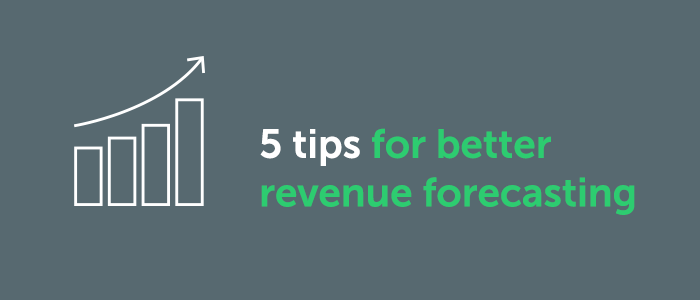5 tips for better revenue forecasting

If you are the Sales VP, CFO, or a CEO of a large, publicly traded company, missing your sales forecast is one of the most disastrous things to get wrong. Analysts in the financial markets expect year-end results to be broadly in line with the guidance they received during company presentations. So a missed sales forecast could lead directly to your stock price plummeting. The situation is little different in North America, with historic data suggesting the drop in stock price may be even greater, at 16.59 percent. Your shareholders and members of the board are going to be upset, too. There is no doubt about it: Getting your revenue forecast wrong at a public company could be the most widely reported event in your career, with your name up there for all to see on the CNBC web page dedicated to earnings and profit warnings.
I doubt if analysts or shareholders really appreciate just how difficult it is for companies to have a clear view of revenue prospects in these rapidly changing times. When growth at home dips down, companies increasingly look to grow sales in new markets where they are less familiar with both macroeconomic conditions and local customer needs. All this makes it difficult to precisely predict revenue. And it becomes doubly difficult when new products or emerging markets are involved since you have no historical data against which to substantiate expectations.
5 Techniques toward creating effective revenue forecasts
Successful companies have proven that revenue forecast accuracy can be increased by implementing rolling reforecasting so that new information is constantly incorporated as the fiscal year progresses. Forecasting, let alone rolling forecasting, can be daunting for companies that can barely get a single annual budget done. Here are five fundamental practices that can significantly enhance your revenue forecast quality.
1. Forecast at the right level of detail
Many revenue forecasts are generated by applying the expected market growth rate to current year sales, then substantiated by detailed planning that takes into account factors such as the number of product units sold, average selling prices, and seasonality. However, some elements of any revenue forecast are always more important than others, so it follows that some need to be forecast in considerable detail while others can simply be aggregated. For instance, you might reforecast every pack size of fast-moving Category A products by modeling current sales orders. But you might instead simply project a forecast for slow-moving Category C product groups and generate a SKU-level forecast for production, based on the mix of recent orders. In many markets, where the growth trends of individual products vary between different geographies, market segments, and channels, revenue forecasts also need to be done at more granular levels and across multiple dimensions in order to achieve any degree of accuracy. Watch to make sure you are forecasting at the right level of detail for the right area.
2. Involve all the key people
Involving too many people in revenue reforecasts adds time and cost to the process. However, allowing head office staff to reforecast by extrapolating trends means risking overlooking important factors that are only known about elsewhere in the business. Smart forecasting involves identifying the people who have specific knowledge of key customers, business channels, and markets, and giving them the ability to input their intelligence into the forecast. This relies on having a planning solution that allows both web and mobile access. That way, local market or product line knowledge can be tapped into to provide valuable information on upcoming demand spikes and troughs that might otherwise go unnoticed.
3. Factor in sales channel productivity
In B2B markets, revenue forecasts always need to reconcile with the company’s sales resource. To develop realistic revenue targets, planners need to understand how much inside or outside sales people can accomplish and how quickly they can realistically convert prospects into customers. In such markets, effective territory and quota planning is an essential precursor to revenue forecasting since sales force productivity, closing rates, and the number of potential customers must be taken into consideration.
4. Constantly revisit assumptions
Bottom-up approaches to revenue forecasting that are rooted in highly granular customer, sales rep, or pack size modeling are always going to yield more accurate numbers. They also give better insight and understanding of how minor changes in underlying assumptions affect revenues and what actions are needed to correct variances. However, planners need to recognize that the majority of the input variables are estimates and that small changes can have large impacts on forecast numbers. Many of these input variables, such closing times and conversion rates, are important key performance indicators that need to be closely monitored, as they are typically the first signs of issues that need management attention.
5. Ratify revenue forecasts against market data
Revenue forecasting is rarely rational. There is often a lot of negotiation about how much revenue is actually needed to cover expenses and make an acceptable profit, so discussions are often driven by emotions rather than commercial reality; therefore, it always pays to run a reality check of any revenue forecasts against a macro view of the market. That way any disparities in market size, market growth, and market share quickly become apparent. Implementing such a top-down check into the revenue forecasting process is quick and easy to do as there are fewer figures to deal with and forecasting is based on general trends.
Adopting these guidelines means introducing more frequent forecasting and building driver-based models that can be quickly updated to account for changes in the sales pipeline and fluctuations in market conditions. Inevitably, you will be using your chosen planning and budgeting solution more frequently and may find it is unable to support the type of dynamic forecasting process you are seeking to implement. If that is the case, then you should read our recent blog post, “What to look for in a solution to support rolling reforecasting”—the second piece in the series on rolling reforecasting. Supported by the appropriate technology, better FP&A processes will make the difference between revenue forecasts that give everyone the best chance of hitting their targets and those that are simply wishful thinking masquerading as sound planning.



